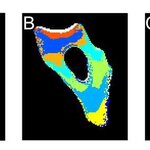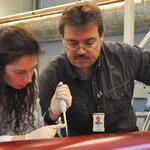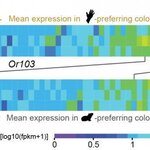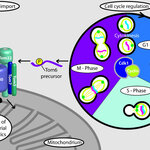Genetics & Molecular Biology

The discovery of the mechanism that enables the enzyme Lecithin: retinol acyltransferase (LRAT) to store vitamin A, a process that is indispensable for vision, may provide a boost for designing small molecule therapies for degenerative eye diseases.
The same enzymatic activity of LRAT that allows specific cells to absorb vitamin A can be used to transport small molecule drugs to the eye. These drugs would accumulate in eye tissue, lowering the effective dose and reducing risk of systemic side effects.
Marcin Golczak, assistant professor of pharmacology at Case Western Reserve and…

When a large protein unfolds in a cell, it slows down and can get stuck in traffic. University of Illinois chemists now can watch the way the unfolded protein diffuses, which could provide great insight into protein-misfolding diseases such as Alzheimer's and Huntington's.
Researchers have hypothesized that an unfolded protein moves more slowly through the cell, because it would be a big, stringy mess rather than a tightly wrapped package. The team devised a way to measure how diffusion slows down when a protein unfolds using a fluorescence microscope, then used three-dimensional diffusion…

Macrophages sweep up cellular debris and pathogens in order to thwart infection - sometimes even before the white blood cells, which are designed for that task.
Neutrophils, white blood cells, are "first responders" that are attracted to wounds by signaling molecules called reactive oxygen species (ROS) that activate a protein kinase. When neutrophils finish their work, inflammation is partly resolved through apoptosis, or cell suicide, and then macrophages arrive to clean up the infection.
But neutrophils can also elect to leave wounded tissue in a process known as reverse migration.…

Alzheimer's disease progresses inside the brain as deposits of the toxic protein amyloid-beta (Aβ),overwhelm neurons. A side effect of accumulating Aβ in neurons is the fragmentation of the Golgi apparatus, the part of the cell involved in packaging and sorting protein cargo including the precursor of Aβ. Or it may be the other way around and loss of Golgi function is a driving force behind Alzheimer's.
Yanzhuang Wang, Gunjan Joshi, and colleagues at the University of Michigan, Ann Arbor, set out to uncover the mechanism damaging the Golgi using a transgenic mouse and tissue culture models of…

Plasmid DNA attached to the outer surface of a sounding rocket may be able to withstand rocket launch, a period of residence in suborbital space, re-entry, and landing conditions into the Earth's atmosphere, all the while staying intact and active in its function as carrier of genetic information, according to a paper published November 26, 2014 in the open-access journal PLOS ONE by Cora Thiel and Oliver Ullrich from University of Zurich (UZH) and colleagues. Applied to the outer shell of the payload section of a rocket using pipettes, small, double-stranded DNA molecules flew…

Scientists have identified four new genes associated with a severe food allergy called eosinophilic esophagitis (EoE), which has only recently been recognized as a distinct condition. Its hallmark is inflammation and painful swelling in the esophagus, along with high levels of immune cells called eosinophils. It can affect people of any age, but is more common among young men who have a history of other allergic diseases such as asthma and eczema.
Eosinophilic esophagitis is often first discovered in children with feeding difficulties and failure to thrive. Because children…

Everyone inherits two copies of most genes, one copy from each parent. In a recent study, researchers found in a rare mutation, people with one inactive copy of the gene NPC1L1 appeared to be protected against high LDL cholesterol, commonly called the "bad" cholesterol, and coronary heart disease, a narrowing of the heart's arteries that can lead to heart attacks.
This mutation meant a 50 percent reduction in the risk of heart attack, at least epidemiologically, according to the paper
in The New England Journal of Medicine. NPC1L1 is of interest because it is the target of the…

The yellow fever mosquito sustains its taste for human blood thanks to a genetic tweak that makes it more sensitive to human odor, according to a paper in Nature. They have a version of an odor-detecting gene in its antennae that is highly attuned to sulcatone, a compound prevalent in human odor.
The gene, AaegOr4, is more abundant and more sensitive in the human-preferring "domestic" form of the yellow fever mosquito than in its ancestral "forest" form that prefers the blood of non-human animals.
The research could help in developing better ways to stem the yellow fever mosquito's…

When a cell divides, it passes through a sequence of complex events and mitochondria, the organelles called the power plants of the cell, are the main source of energy for these processes: They convert food into energy the cell can use.
Freiburg biochemists Dr. Angelika Harbauer and professor Chris Meisinger led a team that have discovered a signaling path that links these two key tasks, cell division and energy conversion. .
When a cell divides, its genetic information is copied and distributed among the resulting daughter cells in a complex process known as mitosis. This process is…

Let’s talk about gastrulation. For those unfamiliar with the term, it’s not as disgusting as it sounds. Gastrulation is a process in early embryonic development which leads to the generation of the three germ-layer tissues- ectoderm, endoderm, and mesoderm- from which all other tissue-types in the body are erived.
The early (amniote) embryo coverts from a bilaminar structure of epithelial tissue plus and extra-embryonic layer, to a trilamiarone. A second function of gastrulation is that it defines the anterior-posterior body axis for the first time. In other words, it begins to…